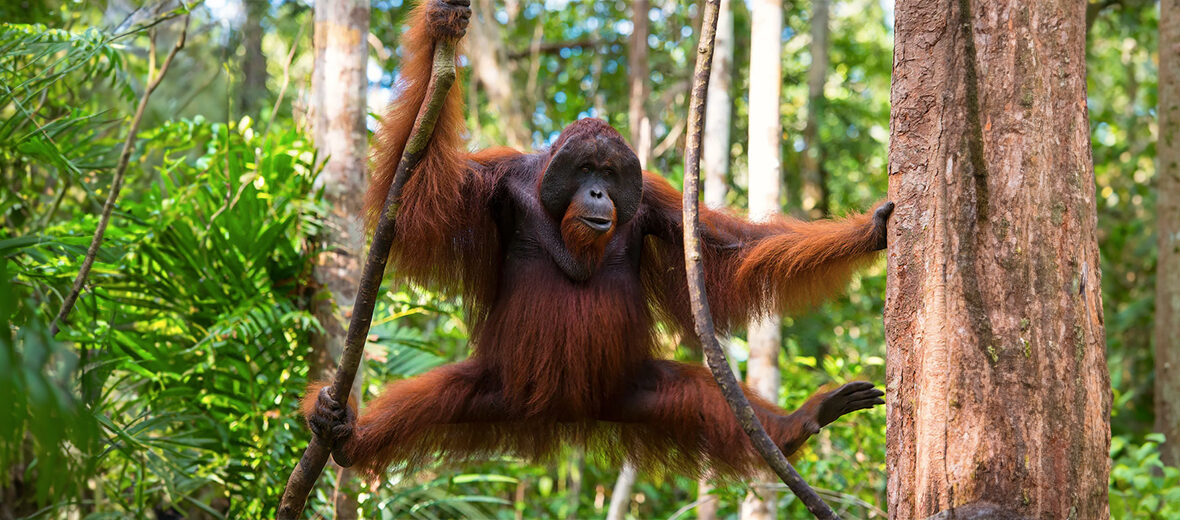
Hailing only from the island of Borneo, it’s the Bornean orangutan. Bornean orangutans happen to be the largest of the 3 species of orangutans. Unfortunately, they face the threats of habitat loss and destruction at the hands of residential and commercial developments, logging, mining, quarrying, fires, and fire suppression; hunting; trapping; and climate change, that causes habitat alterations. The IUCN lists these great apes as Critically Endangered, and their populations are decreasing.
First the Stats…
Scientific name: Pongo pygmaeus
Weight: Up to 220 lbs.
Length: Up to 5.6 feet
Lifespan: Up to 60 years
Now on to the Facts!
1.) Orangutans are the only genus of great apes native to Asia.
2.) Orangutans are extremely intelligent, and display tool use as well as particular cultural patterns in the wild.
3.) These critters are also called mias by the locals.
4.) The divergence between Sumatran and Bornean orangutans occurred approximately 400,000 years ago.
5.) The 2 orangutans were thought to be subspecies until 1996; where they were elevated to separate species following sequencing of their mitochondrial DNA.
But wait, there’s more on the Bornean orangutan!
6.) There are currently 3 subspecies of Bornean orangutans recognized: northwest (Pongo pygmaeus pygmaeus), northeast (Pongo pygmaeus morio), and central (Pongo pygmaeus wurmbii).
7.) They prefer tropical rain forests in the Bornean lowlands, as well as montane rain forests located in mountainous areas up to 4,900 foot elevations.
Did you know…?
Orangutans share nearly 97% of their DNA with humans. Which means that from a genetic standpoint we are only 3% removed from these amazing beings.
8.) These apes travel considerable distances to find fruit bearing trees.
9.) Bornean species are more solitary than Sumatrans and only come together in small troops of up to 3 individuals. But these gatherings are temporary and often associated with mating.
10.) Even though they aren’t necessarily territorial, males will often display threatening behaviors towards each other upon meeting.
But wait, there’s still more on the Bornean orangutan!
11.) Even though they are considered to be arboreal (spend their lives in trees), they spend more time on the ground than Sumatran orangutans.
12.) Exhibiting nest-building behavior, these critters will build new nests each night among the trees.
Did you know…?
The construction of nests is considered tool utilization and not animal architecture.
13.) Nests can be quite detailed and include a foundation and mattress constructed by intertwining leaves and branches, and adding broken leafy branches to top it off.
14.) Juveniles learn the skill of nest building by observing their mothers.
15.) They consume over 400 types of food. Food items include wild figs, durians leaves, seeds, bird eggs, flowers, sap, vines, honey, fungi, spider webs, insects, and bark. Soil is also consumed to gain needed minerals.
But wait, there’s still a little more on the Bornean orangutan!
16.) These critters have been seen using spears to attempt (albeit unsuccessfully) to catch fish. They use tools like leaves to wipe off feces (poop), leafy branches held together for an umbrella when it rains, a pad of leaves for holding spiny durian fruit, leafy branches for a bee swatter, a stick as backscratcher, and a branch or tree trunk as a missile.
17.) Subadult males often attempt to mate with any available female and are successful about half the time.
Did you know…?
During the first year of its life, the infant will cling to its mother’s abdomen by entwining its fingers in and gripping onto her hair.
18.) Dominant flanged (possess cheek pads) males will advertise their position to receptive females via calling. Females prefer mating with flanged males. Also noted is the males will typically go after females who have a juvenile as they tend to be thought of as more fertile.
19.) Females undergo up to a 259 day gestation (pregnancy) that yields a single infant.
20.) Newborns nurse every 3 – 4 hours, and start to take soft food from their mothers’ lips by 4 months of age.
But wait, there’s still a tad more on the Bornean orangutan!
21.) Due to human activities and developments the population of these orangutans is less then 14% of what it used to be in the middle of the 20th century.
22.) The population of around 6,900 is currently located in Sabangau National Park, however this environment is at risk due to developments.
Did you know…?
There are more Bornean orangutans than Sumatrans left in the wild, to date. Borneans number an estimated 104,700, where Sumatrans number only an estimated 14,000.
23.) Due to the practice of illegal logging, fires, and the extensive development of palm oil plantations, orangutans are Critically Endangered, and if the current trend isn’t culled, they will most certainly become extinct.
24.) Palm oil accounts for over 1/10th of Indonesia’s export earnings. It is in such high demand due to it being used in numerous baked goods, candies, deodorants, packaged foods, shampoos, and soaps. So, due your part by avoiding products that utilize palm oil.
25.) The Orangutan Foundation, founded by Ashley Leiman, operates programs in Borneo, Central Kalimantan, and Indonesia. The Foundation rescues orphaned orangutans and introduces them into their soft-release program, allowing them to develop the skills needed to survive in the wild.
Now a Short Bornean Orangutan Video!
This video talks about orangutans in general.
Be sure to share & comment below! Also, check out the Critter Science YouTube channel. Videos added regularly!
Want to suggest a critter for me to write about? Let me know here.
Some source material acquired from: Wikipedia & IUCN
Photo credit: Britannica




